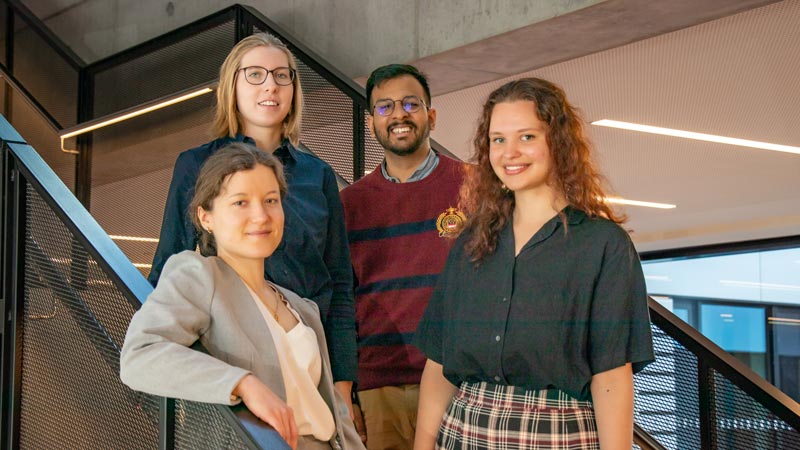Four of eight nominated DIGS-BB PhD students received the DIGS-BB Fellow Award 2024:
- Birte Doludda (Gerd Kempermann Group)
- Yuliia Haluza (Maximina Yun Group)
- Sukrit Mahajan (Mirko Schmidt Group)
- Jessica Nitsche (Michael Sieweke Group)
The award honours outstanding PhD students after the 1st year of thesis work and includes a price money of €2,000. It aims to help their research work, development of research skills, and to strengthen their research network. The allowance can be used to cover project consumables, attendance to workshops and conferences, research visits to collaborators’ labs, as well as to cover cost for a side project.
An outstanding performance during the 1st year of PhD work, along with a nomination and justification by their Thesis Advisory Committee (TAC) in the 1st AR TAC meeting is required to be eligible for the award. The students presented the current state of their thesis work to the DIGS-BB Steering Committee in writing. Applications positively evaluated were invited to defend their application in a chalk talk before the committee. Detailed information on that work can be found below.
Birte Doludda
The impact of social activity on individualization
It is known that an enriched environment (ENR) promotes adult hippocampal neurogenesis, a rare case of brain plasticity, and the process of individualization. Social activity is one aspect of ENR that can be a potential driver of individualization and brain health. Although ENR offers more social opportunities, the way in which each subject utilizes the given extended social opportunities as part of the shared and non-shared environment is individual. The research objective of my PhD project is to develop mathematical and computational methods that define measures of social behavior based on data derived from an automated home cage tracking system and, furthermore, to validate these social measures with respect to their biological significance. Moreover, I want to determine how these different social measures relate to adult hippocampal neurogenesis and to the process of individualization of mice. To minimize the genetic component in this interplay between environmental driven social behavior and brain plasticity, we use isogenic mice. For this project, I employ a large automated cage system, equipped with built-in antennas, to spatio-temporally track RFID-tagged mice over long time periods. The locational data is analyzed using bioinformatic techniques that determine the emergence of stable, individual behavioral patterns in the realm of social activity. The obtained social parameters can be related to further results gained from behavioral tests and brain/hippocampal histology. This project is relevant for general behavioral research as it substantially improves the intervention-free assessment of the behavior of large colonies of mice over long time periods, further dissects the complex behavioral activities of a mouse colony towards social behavior, and informs us about the importance of the social aspect within the environment.
Yuliia Haluza
Enabling the axolotl as an ageing model
The interest in ageing causes and ways of its prediction is evolving. While molecular ageing markers are studied in mammals, examining salamanders like axolotls, which resist age-related diseases and show minimal signs of decline, can enhance our understanding of ageing. Developing tools for studying axolotl ageing could make it a valuable model for ageing research. In my PhD project, I aim to leverage the molecular markers of ageing to uncover whether and how the axolotl ages at the molecular level. Additionally, I intend to address the question of ageing and regeneration interconnection, as regeneration mechanisms may be of relevance for understanding the impressive lack of age-related decay observed in salamanders. Getting a clear idea of the molecular changes happening throughout the lifespan of axolotls may bring us closer to understanding the origin of age-related disorders in mammals as well as finding ways to prevent them.
Sukrit Mahajan
Role of EGFL7 in immune evasion by malignant glioma
Brain tumours that originate from glial cells such as astrocytes and oligodendrocytes, are referred to as gliomas. The most aggressive form of glioma, with a poor prognosis and median survival rate of 15 months, is called glioblastoma multiforme (GBM). It is characterized by evasion of immune response, rapid growth, extensive angiogenesis and peritumoral invasion into the brain parenchyma. Recent evidence indicates that the glioma microenvironment (GME) supports immune evasion, which is of particular importance for glioma progression. EGFL7 protein, an angiogenic factor, found in the GME, is highly expressed in GBM compared to other types of gliomas. Studies suggest that EGFL7 alters glioma-resident immune cells, however the molecular mechanisms by which EGFL7 alters immune cell populations have not yet been identified. Therefore, my project focuses on uncovering the role of EGFL7 in immune evasion by malignant glioma. This would further help in unravelling immune escape mechanisms relevant for malignant brain tumours, thereby leading to the development of alternate therapeutic strategies against GBM.
Jessica Nitsche
Evaluation of genetically-modified macrophages in response to tumor-induced reprogramming and tumor fibrosis
Macrophages, as tissue-resident immune cells, play pivotal roles in maintaining tissue homeostasis and responding to various physiological challenges such as injury, inflammation, and infection. Their remarkable ability to adapt to environmental cues makes them essential gatekeepers of tissue integrity throughout life. Moreover, in the context of cancer, macrophages exhibit a fascinating behavior: they accumulate in tumorigenic areas and emerge as the predominant immune cell population. In our group, we focus on harnessing the potential of macrophages for cellular therapies in cancer treatment by using their innate homing capabilities to solid tumors and exploiting their diverse repertoire of anti-tumorigenic effector functions. In my project, I investigate these macrophage-mediated tumor killing mechanisms and set up in vivo tumor models to evaluate macrophage functionality across different tumor types.
